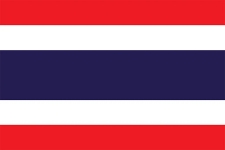
The ties between Thailand and Korea go back centuries. According to the Koryo-Sa 고려사 (高麗史), the official History of the Koryo Dynasty 고려 (高麗 918–1392), the kingdom of Seomna-gok (暹羅斛國) sent Nai Gong 내공 (奈工) with gifts and a letter of introduction to the Korean monarch Gongyang 공양 (恭讓, 1389-1392) arriving during the 3rd year of his reign (July 3, 1391, Lunar Calendar). There are no surviving records of this encounter in Thailand. On June 16, 1393, in the Annals of King Taejo’s 태조 (太祖, personal name Yi Seong-gye 이성계 李成桂 1335-1408), it is recorded that an emissary from Thailand appeared, with tribute items. After Taejo seized power in 1392, he initially showed an active interest in trade with Thailand and dispatched envoys to Thailand. However, his interests quickly faded, due to the distances involved and because of Japanese pirates who were ever present. Thailand officially recognized the Republic of Korea on October 21, 1949. Formal diplomatic relations between the Kingdom of Thailand and the Republic of Korea were established on October 1, 1958.
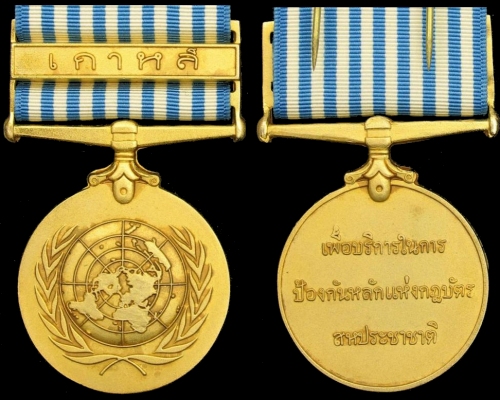
The Korean War
On June 30, 1950, five days after the Korean War began; Thailand sent 4 tons of rice to South Korea. Traditionally, Thailand was committed to a policy of neutrality. Although still suffering as a direct result of World War II, they decided to participate in the war. This provided a challenge to the communists in Thailand, who publicized that “only Western imperialists would dispatch troops to Korea.” The Thai government decided to send 1 mixed military force, with approximately 4,000 personnel, to fight with the United Nations in Korea. They contributed naval, air, and ground forces, as well as medical units. On July 29, 1950, the Thai Ministry of Defense กระทรวงกลาโหม announced the recruitment of volunteer soldiers to serve with the United Nations forces. A total of 14,998 people applied. The army received a royal command to send military forces to operate together with United Nations forces in the Korean War on Sept. 22, 1950. Later, on September 29, 1950, there was a royal command to send naval forces and the Air Force to participate in the Korean War.
Royal Thai Army กองทัพบกไทย
Thailand was the first Asian country and second only to the United States to announce its intent to send troops to fight in the Korean War. Thailand contributed a battalion-size unit of 1,000 soldiers. The advance element led by Major Surakit Mayalap arrived in Korea on Oct. 3, 1950. On Oct. 22, 1950, approx. 1,200 Thai soldiers traveled to Korea on the cargo ship “Hertamersk” “เฮอร์ตาเมอร์สก” departing from the port of Khlong Toei คลองเตย in Thailand. They were escorted by 3 Thai Royal Navy ships. The ground forces consisted of 3 infantry battalions, 1 artillery battalion, 1 communications division, 1 engineering division, and 1 reconnaissance division. They arrived in Pusan on Nov. 7, 1950, and then took a train to the United Nations military reception center at Taegu. The battalion was deployed to the front at Pyongyang on Jan. 22, 1952. The Thai military had its first encounter with the enemy on Nov. 29, 1950. Thai troops made significant contributions at the Battle of Pork Chop Hill, which began on Nov. 1, 1952. Pork Chop Hill’s represented a strategic location for both sides of the fighting. After stopping three waves of enemy attacks, which included hand-to-hand combat and fighting back a counteroffensive, the Thai army achieved victory in taking the hill. For their actions at Pork Chop Hill, soldiers from the 21st Thai Infantry Battalion were awarded one U.S. Legion of Merit (Major Kriangsak Chamanan), 12 Silver Stars, and 26 Bronze Star Medals. The Commander of the 8th U.S. Army, General James Van Fleet, gave them the nickname the “Little Tigers” พยัคฆ์น้อย. Thai support was important in other battles, such as the Third Battle of Seoul and the Battle of Chatkol. In summary, Thailand sent 6 contingents of soldiers to fight with the United Nations in the Korean War, with the first contingent on arriving on Nov. 7, 1950 and the last one departing on May 22, 1954. From Nov. 7, 1950 until the armistice on July 27, 1953, there were 3,650 Thai soldiers who served. By May 22, 1954, some 10,315 soldiers had served in Korea.
Royal Thai Navy กองทัพเรือไทย
Thailand initially sent two naval frigates and one transport ship. The two Thai warships HTMS Prasae (served Nov. 7, 1950 until it was scuttled on Jan. 7, 1951) and HTMS Bangpakong (served Nov. 7, 1950 until Feb. 16, 1952) along with the transport ship, HTMS Sichang (served Nov. 7, 1950 to July 15, 1951). The warships provided patrol and escort duties for United Nations Command and were replaced in December 1951, with two new frigates, HTMS Tachin (formerly the USS Glendale) and HTMS Prasae II (formerly USS Gallup). Both departed South Korea on Jan. 22, 1955. The Thai naval frigates served on the U.S. Naval Command Far East’s Blockade and Escort Force.1 The Thai Royal Navy served in Korea from Nov. 7, 1950 until Jan. 31, 1955. There were 2,485 Thai naval personnel who participated.
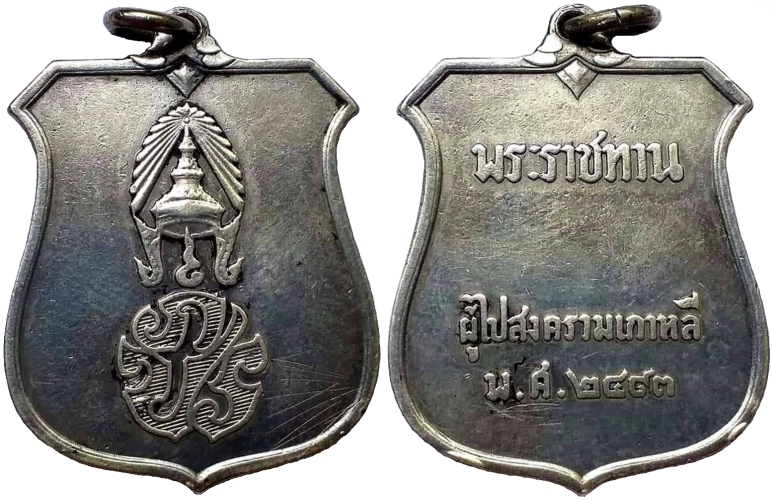
On the front is the Royal cipher of Bhumibol Adulyadej (1927 – 2016, r.1946-2016), more commonly known as King Rama IX. His cipher includes everything seen on the front, including the crown2, his monogram ภปร (Phor Por Ror) etc. The reverse carries the inscription พระราชทาน ผู้ไปสงครามเกาหลี พ.ศ.๒๔๙๓ “Awarded to those who went to the Korean War in 1950”. What in the west is considered an overall “Shield” shape is, in fact, indicative of a Thai Buddhist amulet.
Royal Thai Air Force กองทัพอากาศไทย
The Royal Thai Air Force supplied a C-47 transport aircraft for airlift operations and three task force contingents during and after the Korean War. Air Liaison Officers and Airlift Mission Teams arrived on June 24, 1951. Initially, the Royal Thai Air Force arranged for 3 C-47 transport aircraft with 17 personnel, consisting of a unit leader who was a pilot, 8 pilots, 4 air technicians, and 4 communications officers. Later, 1 financial officer and 1 clerk were added. Their main purpose was transporting the wounded, often flying wounded Thai troops back to Thailand. The Royal Thai Air Force C-47s remained in South Korea until Nov. 6, 1964. The US government provided two C-123 B aircraft to the Royal Thai Air Force on Nov. 14, 1968. The Airlift Mission Teams and the Air Liaison Officer Teams departed in 1971. The Thai Air Force Detachment assigned to Headquarters, UN Command (Rear) finally departed via their two C-123 aircraft on July 26, 1976. There were 45 air force officers and crew members who served during the Korean War from Jun. 1951 until July 27, 1953. By July 30, 1976, there had been 24 contingents that rotated to Korea.
Thai Medical Service Detachments
Thai medical support included a Thai Air Force Medical Detachment, a Red Cross Medical Service Detachment, and a Mobile Surgical Hospital. When the Korean War broke out, Mr. Delverly, the U.S. Red Cross organization’s overseas operations executive, sent a letter on Aug. 9, 1950, to Her Royal Highness Princess Chumphat Bongsaboribatra requesting support from the Red Cross of Thailand สภากาชาดไทย. Subsequently, the Vice President of the Thai Red Cross Society sent a letter to the Minister of Defense on August 19, 1950, requesting support in sending a medical unit to help in the Korean War. During the war, the Red Cross of Thailand sent 4 separate groups of personnel. No medical personnel were lost during the Korean War. The Red Cross teams served from Nov. 7, 1950 until Nov. 13, 1953. They were required to wear military uniforms, however in line with the principles of the International Red Cross, they did not wear any military insignia. The first Air Force Nursing Team arrived on Dec. 26, 1950 and after several rotations of personnel, they departed in 1974. The Air Ambulance team served in Korea from Jan. 11, 1951 to July 26, 1976, with a total of 29 rotations during the years 1950 – 1955. Dr. Kasem Chinprahas and nurse Pranee Intuset were awarded the U.S. Medal of Freedom for their exceptionally outstanding service.
Conclusion
The Thai forces would be among the last to depart Korea after the war, maintaining at least one company-sized combat unit in Korea from July 1955 until July 1972. In total, there were 17 rotations. There is a total of 11,776 Thais who have served in Korea between Oct. 3, 1950 until June 21, 1972. That period was long enough to span multiple generations. Colonel Boriboon Chulacharitta (later General) was the commander of the first Thai contingent (1st Battalion of the 21st Thai Regiment) during the Korean War. His son, Maj. Euaamsak Chulacharitta (later General), was stationed in the Republic of Korea and oversaw the departure of the last Thai combat unit from the Republic of Korea on June 21, 1972. For nearly twenty years after the armistice, twenty Thai airmen have volunteered to serve in Korea for a one-year tour. Thailand continues to contribute personnel supporting the UNC mission at the UNC Military Armistice Commission-Secretariat (UNCMAC-S). They maintain one liaison officer and 7 enlisted men at the Armistice Committee and one officer with six enlisted men as members of the United Nations Command Honor Guard Company currently located at Camp Humphrey, in Pyeongtaek, Kyonggi-do.3 In all, the Royal Thai Expeditionary Forces have totaled more than 13,000 servicemen who have served since Oct. 3, 1950.
During the war, Thailand suffered 93 killed in action (Army 91, Navy 2), 36 who suffered non-battle deaths (Army 34, Navy 2), 1,139 casualties (318 wounded in action, 821 non-battle injuries) and five who are listed as MIA. All the Thais, who died while serving in Korea, were returned to Thailand for burial.
There is a Thai Memorial, dedicated on Nov. 4, 2008, at the United Nation’s Cemetery in Korea (UNMCK 재한유엔기념공원) . There is another Thai Memorial at Munam-ri, in Pocheon City (the last garrison location of Thai combat troops). It was built to commemorate the service of the Thai forces who have served in Korea and to honor the Thai servicemen who gave their lives. The memorial is shaped like 3 rifle butt stocks (to symbolize war). There is also a statue of a soldier and a civilian with their arms around each other’s shoulders. About 50 meters from the memorial is a small Thai-style Buddhist temple that houses a seated Buddha. It was built in 1994 to celebrate the 50th year of King Bhumibol Adulyadej’s (Rama IX) reign and is believed to appease the souls of Thai soldiers who sacrificed their lives in Korea.
In Thailand, there is a Korean War Veteran’s Museum พิพิธภัณฑ์ทหารผ่านศึกเกาหลี in Chonburi Province จังหวัดชลบุรี. The Thai naval vessel, the HTMS Prasae II was decommissioned from the Royal Thai Navy in 2000. She is currently located at the mouth of the Prasae River, Rayong Province in Thailand. On Dec. 27, 2003, she was dedicated as the HTMS Prasae Battleship Memorial อนุสรณ์เรือรบหลวงประแสa and Korean War museum. In Thailand, October 22 is celebrated yearly as Korean War Veteran’s Memorial Day วันที่ระลึกทหารผ่านศึกสงครามเกาหลี.
Awards received by the Military Forces of Thailand
The Thai Army received three Republic of Korea Presidential Unit Citations. The 1st Battalion, 21st Thai Regiment received two of them, one on Apr. 8, 1954, and the other on May 20, 1954. The Royal Thai Company (19th Rotation Co.) received one on Jun. 11, 1968. For the Order of Military Merit, Korea awarded 7 Ulchi Class Medals, 26 Chungmu Class Medals, 16 Hwarang Class Medals and 1,116 Korean War Service Medals.
From the United States, Thailand received 13 Silver Stars, 6 Legions of Merit, 25 Bronze Stars with “V” for Valor device, 34 Bronze Stars (26 Army, 4 Navy and 4 Air Force). The Air Force also received 3 Air Medals. There were 1,313 Unit Citation Ribbons issued.
From Belgium, they received 6 “Medals of Merit”. Exactly which medal was awarded is not clear. The information was obtained from the R.O.K. “History of the U.N. Forces” Volume VI.
From the United Nations, the Army received 8,106 U. N. Service Medals and the Navy received 1,679.
From the Thai government, they received 37 Distinguished Service Medals, 10,376 Korean Service Medals, 344 Medals for Wounded in Action and 24 Bravery Medals.
- For the Thai Army awards, the numbers cited cover from the first contingent through the 14 rotation contingent.
The Thai Bravery Medal เหรียญกล้าหาญ
The Thai Bravery Medal เหรียญกล้าหาญ, used during the Korean War, was originally instituted on Feb. 3, 1941 during the reign of King Ananda Mahidol, King Rama VIII. It is awarded to soldiers, police officers, military units and those who carry out their duties as soldiers or police officers for bravery against the enemy. Its Post-nominal letters are ร.ก. “R.K.”. It replaced the Dusadeemala Medal เหรียญดุษฎีมาลา (est. 1882). The Bravery Medal was revised again with the enactment of the Bravery Medal Act, B.E. 2521 (1978), which is still current today.
The medal is awarded in two classes: Bravery Medal with Wreath and Bravery Medal. The Bravery Medal with Wreath is a second award of the bravery medal and has a gold suspension device in the shape of a Chaiyaphruek bouquet.
The obverse of the planchet is identical to the Victory Medal. It portrays King Naresuan the Great on a charging war elephant. There is an inscription that says สมเด็จพระนเรศวรมหาราช กู้ชาติ “King Naresuan the Great saves the nation”. The 35 mm ribbon is divided equally between red and white stripes.4 At the top of the ribbon is a metal pin in the shape of a field marshal’s scepter, inscribed with the words กล้าหาญ “brave”. On the back there is an inscription that reads: เรากล้ารบเพื่อเกียรติศักดิ์ไทย “We dare to fight for Thai honor”. The medal comes with a certificate which carries the royal seal. When a recipient dies, the medal is given to the person’s legal heirs. If an heir wears the medal, it is considered a serious offense which has legal consequences. If the recipient is later convicted of a serious crime, the medal can be rescinded.
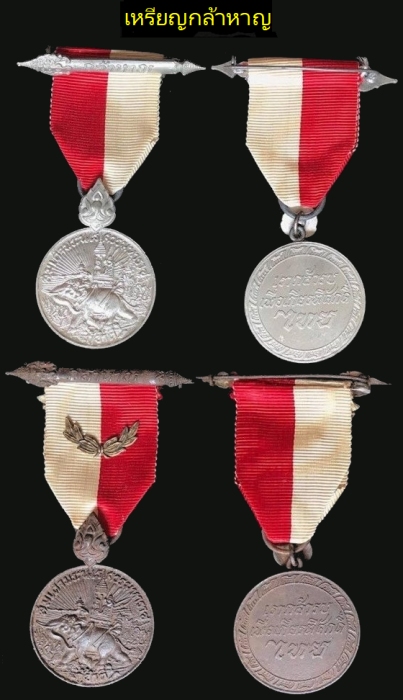
During the Korean war, all 24 recipients were members of the Royal Thai Army. Fourteen of the twenty-four medals were awarded after the Armistice was signed. None of the awarded medals have the Chaiyaphruek bouquet suspension device. The following list is spelled out as it appears in the Royal Gazette.
- Lieutenant Peeraphon Chotchuang ร้อยโท พีรพล โชติช่วง July 25, 1951
- Corporal Stim Kasuaythong สิบตรี สติม กะสวยทอง July 25, 1951
- Private Chumphon Sitha พลทหาร ชุมพล สีทา July 25, 1951
- Major Chamnian Phongpairoj Sept. 11, 1951
- Lieutenant Ruea Sumano พันตรี จำเนียร พงศ์ไพโรจน์ Sept. 11, 1951
- Lieutenant Chamnian Meesanga ร้อยโท เรือ สุมะโน Sept. 11, 1951
- Sergeant Major Yodchai Machakram ร้อยโท จำเนียร มีสง่า Sept. 11, 1951
- Corporal Phin Malenet จ่าสิบเอก ยอดชาย มัจฉากร่ำ Sept. 11, 1951
- Corporal Prasert Rakchan สิบตรี ประเสริฐ รักษ์จันทร์ April 1, 1952
- Lieutenant Colonel Ong Phothikanit พันโท อ่อง โพธิกนิษฐ April 2, 1953
- Lieutenant Chalerm Siriboon ร้อยโท เฉลิม ศิริบุญ Oct. 2, 1953
- Sergeant Major Thammanoon Somwang สิบเอก ธรรมนูญ สมหวัง Oct. 2, 1953
- Second Lieutenant Wichian Kanchanawong ร้อยตรี วิเชียร กาญจนะวงศ์ Nov. 27, 1953
- Lieutenant Wichian Sangkhapraiwan ร้อยโท วิเชียร สังขไพรวัน May 11, 1954
- Sergeant Major Nop Wiboonpacha จ่าสิบเอก นพ วิบูลย์พาชย์ May 11, 1954
- Corporal Thongyu Chomsiri สิบโท ทองอยู่ โฉมสิริ May 11, 1954
- Corporal Choti Sanprasert สิบตรี โชติ สรรค์ประเสริฐ May 11, 1954
- Private Juerak Kitprachum พลทหาร จือรักษ์ กิจประชุม May 11, 1954
- Captain Prasert Singhakul ร้อยเอก ประเสริฐ สิงหกุล Sept. 18, 1954
- Lieutenant Colonel Phati Yotkrai พันโท ผาติ ยศไกร Oct. 20, 1954
- Major Juan Wannarat พันตรี จวน วรรณรัตน์ April 6, 1955
- Captain Akkaphon Somrup ร้อยเอก อรรคพล สมรูป April 6, 1955
- Corporal Sangwan Sriruangsin สิบตรี สงวน ศรีเรืองสิน April 6, 1955
- Private Thongchua Chaipanya พลทหาร ทองเจือ ฉายปัญญา April 6, 1955
Victory Medal for fighting with the United Nations in Korea เหรียญชัยสมรภูมิ สงครามร่วมรบกับสหประชาชาติ ณ ประเทศเกาหลี5
The (original) Victory Medal was created by the Victory Medal Decree of 1941 during the reign of King Ananda Mahidol. There have been 4 different Victory Medals issued, all with the same planchet but different ribbon colors. In the Thai hierarchy, it ranks just below the Bravery Medal.

There is no award document accompanying the medal, but the name of the recipient is recorded and announced in the Royal Gazette. The Victory medal used for the Korean War is officially called เหรียญชัยสมรภูมิ สงครามร่วมรบกับสหประชาชาติ ณ ประเทศเกาหลี “Victory Medal for fighting with the United Nations in Korea”, but it is more commonly called the “Korean War Victory Medal”. The Medal was instituted in 1953 and is awarded to military personnel who served with the United Nations Forces in the Korean War. Its Post-nominal letters are ช.ส. “CS”.
The ribbon is the United Nations “Blue and White” and 35 mm wide. Above the ribbon is a metal bar in the shape of a field marshal’s scepter with the inscription: ชัยสมรภูมิ “Victory”. On the obverse of the planchet, there is a depiction of King Naresuan the Great (1555-1605 CE) สมเด็จพระนเรศวรมหาราช on a charging war elephant. The inscription reads: สมเด็จพระนเรศวรมหาราช กู้ชาติ “King Naresuan the Great saved the nation”. On the reverse there is an inscription that reads: เรารบเพื่อเกียรติศักดิ์ไทย “We fight for Thai Honor.” Originals are in white metal, but there are more contemporary examples found in bronze or gold gilt.
If the person who receives the Victory Medal whose actions received praise from the government or committed an act that caused serious injury to the enemy, they will receive a suspension device in the shape of a gold Bomb Burst. If the awardee has performed a heroic deed that is not quite to the point necessary to receive the Royal Bravery Medal เหรียญกล้าหาญ, they receive a gold suspension device in the shape of a single bouquet of Chaiyapruek.6
There are Western websites which assert that the suspension devices are for a 2nd or 3rd tours, but that information is not corroborated on Thai websites.
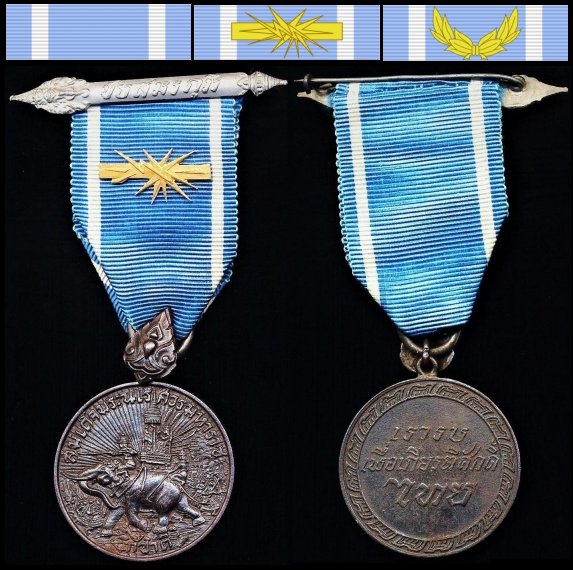
Footnotes:
- From July 12, 1945, until Nov. 16, 1949, the USS Glendale / HTMS Tachin was on loan to the Soviet Union’s navy under Lend-Lease.
- The Great Crown of Victory พระมหาพิชัยมงกุฎ (Phra Maha Phichai Mongkut) is the most important of the 5 regalia of Thailand. (Makuṭa, Sanskrit: मुकुट)
- The Honor Guard Company’s current composition includes soldiers from the United States, South Korea, Thailand, and the Philippines.
- The Satabarsa Mala, Commemorative Medal issued during the Rattanakosin Centennial Celebration has the same ribbon but with the stripes reversed.
- Also translated as “Medal Joint War with the United Nations in Korea”.
- In symbolic usage, Chaiyaphruek (Ratchaphruek) is an auspicious plant. The name means “Tree of Victory”, or “To overcome some obstacle”. The leaves are used to make garlands for the head. It was a great honor for poets and musicians in ancient times. Chaiyaphruek bouquets are found in many places, such as the epaulettes of government and military officials and on the hats of soldiers and policemen.
